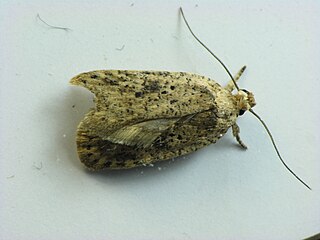
Heterocrossa gonosemana is a species of moth in the family Carposinidae. It is endemic to New Zealand.

Agonopterix senicionella is a moth in the family Depressariidae. It was described by August Busck in 1902. It is found in North America, where it has been recorded from Kentucky, Michigan, Ohio, Virginia and West Virginia.
Agonopterix pteleae is a moth in the family Depressariidae. It was described by William Barnes and August Busck in 1920. It is found in North America, where it has been recorded from Illinois, Michigan and Ohio.
Nites maculatella is a moth in the family Depressariidae. It was described by August Busck in 1908. It is found in North America, where it has been recorded from Vermont, Ontario, Pennsylvania, Ohio, Indiana, Kentucky, Maine, Maryland and West Virginia.
Epermenia albapunctella is a moth in the family Epermeniidae. It was described by August Busck in 1908. It is found in North America, where it has been recorded from Illinois, Indiana, Maine, Minnesota, New Brunswick, North Carolina, Northwest Territories, Nova Scotia, Ohio, Ontario, Pennsylvania and Quebec.
Chionodes psiloptera is a moth in the family Gelechiidae first described by William Barnes and August Busck in 1920. It is found in North America, where it has been recorded from Quebec to British Columbia and then to Alaska, eastern Washington, Montana and New York.
Chionodes retiniella is a moth in the family Gelechiidae first described by William Barnes and August Busck in 1920. It is found in North America, where it has been recorded from Idaho, Wyoming, Nevada, British Columbia, Washington, Colorado, New Mexico, Arizona and California.
Chionodes xanthophilella is a moth in the family Gelechiidae first described by William Barnes and August Busck in 1920. It is found in North America, where it has been recorded from California, Arizona, Nevada, New Mexico, Texas and North Dakota.
Coleotechnites elucidella is a moth of the family Gelechiidae described by William Barnes and August Busck in 1920. It is found in North America, where it has been recorded from California.
Gelechia benitella is a moth of the family Gelechiidae described by William Barnes and August Busck in 1920. It is found in North America, where it has been recorded from Texas.
Sophronia roseicrinella is a moth of the family Gelechiidae. It was described by August Busck in 1909. It is found in North America, where it has been recorded Texas.
Gnorimoschema batanella is a moth in the family Gelechiidae. It was described by August Busck in 1903. It is found in North America, where it has been recorded from California, Illinois, Kentucky, Maine, New Jersey and Ontario.
Gnorimoschema dudiella is a moth in the family Gelechiidae. It was described by August Busck in 1903. It is found in North America, where it has been recorded from Arizona and Texas.
Gnorimoschema coquillettella is a moth in the family Gelechiidae. It was described by August Busck in 1902. It is found in North America, where it has been recorded from California and Colorado.
Aristotelia lindanella is a moth of the family Gelechiidae. It was described by William Barnes and August Busck in 1920. It is found in North America, where it has been recorded from California.
Aristotelia monilella is a moth of the family Gelechiidae. It was described by William Barnes and August Busck in 1920. It is found in North America, where it has been recorded from Illinois, Kentucky, North Carolina and Florida.
Monochroa fragariae, the strawberry crown miner moth, is a moth of the family Gelechiidae. It was described by August Busck in 1919. It is found in North America, where it has been recorded from Oregon and British Columbia.
Taygete sylvicolella is a moth in the family Autostichidae. It was described by August Busck in 1903. It is found in North America, where it has been recorded from Illinois, Maine, New York, Ohio and South Carolina.
Antaeotricha mitratella is a moth in the family Depressariidae. It was described by August Busck in 1914. It is found in Panama.
Antaeotricha irene is a moth in the family Depressariidae. It was described by William Barnes and August Busck in 1920. It is found in North America, where it has been recorded from Texas.


